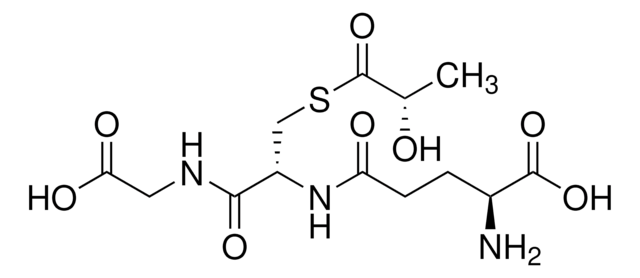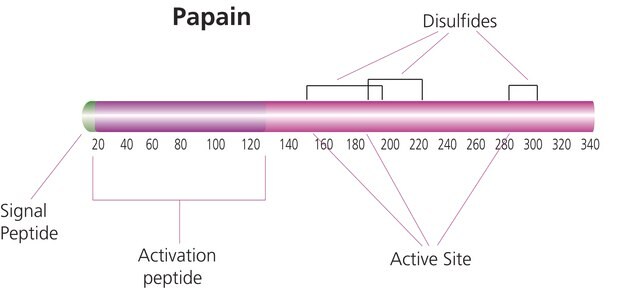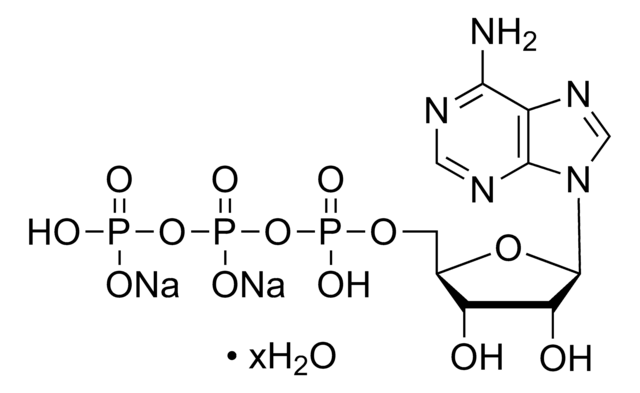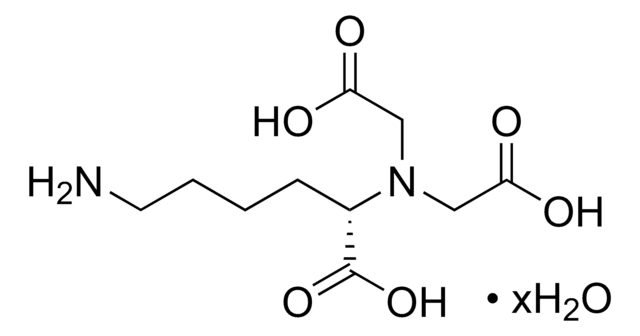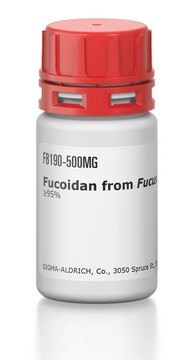Wszystkie zdjęcia(1)
Kluczowe dokumenty
G4252
Glyoxalase I from Saccharomyces cerevisiae
Grade IV, buffered aqueous glycerol solution, ≥400 units/mg protein
Synonim(y):
S-Lactoyl-glutathione methylglyoxal-lyase (isomerizing)
Zaloguj sięWyświetlanie cen organizacyjnych i kontraktowych
About This Item
Numer CAS:
Numer MDL:
Kod UNSPSC:
12352204
NACRES:
NA.54
Polecane produkty
typ
Grade IV
Poziom jakości
Formularz
buffered aqueous glycerol solution
aktywność właściwa
≥400 units/mg protein
obecność zanieczyszczeń
glyoxalase II ≤1%
temp. przechowywania
2-8°C
Szukasz podobnych produktów? Odwiedź Przewodnik dotyczący porównywania produktów
Opis ogólny
Glyoxalase detoxification system consists of glyoxalase (GLO)-I and GLO-II. GLO-I is a cytosolic, 42 kDa, dimeric Zn2+ metalloenzyme.
Zastosowanie
Glyoxalase I from Saccharomyces cerevisiae has been used as a standard in Glyoxalase I assay for C. dilatata females and brooded encapsulated embryos. It has also been used as a standard for calibration curve generation for quantifying glyoxalase I from brain tissues and cerebral microvessels.
Działania biochem./fizjol.
Glyoxalase I is universally expressed and involved in the protection against cellular damage due to cytotoxic metabolites such as advanced glycation end products (AGEs). It is an integral component of the detoxification system, catalyzing the conversion of reactive, acyclic a-oxoaldehydes into the corresponding a-hydroxyacids in a glutathione-dependent manner.
Definicja jednostki
One unit will form 1.0 μmole of S-lactoylglutathione from methylglyoxal and reduced glutathione per min at pH 6.6 at 25 °C.
Postać fizyczna
Solution in 50% glycerol, 0.4 M (NH4)2SO4 and 0.002 M KH2PO4 pH 6.5
Komentarz do analizy
Protein determined by biuret.
Ta strona może zawierać tekst przetłumaczony maszynowo.
Kod klasy składowania
10 - Combustible liquids
Klasa zagrożenia wodnego (WGK)
WGK 3
Temperatura zapłonu (°F)
Not applicable
Temperatura zapłonu (°C)
Not applicable
Środki ochrony indywidualnej
Eyeshields, Gloves, multi-purpose combination respirator cartridge (US)
Wybierz jedną z najnowszych wersji:
Masz już ten produkt?
Dokumenty związane z niedawno zakupionymi produktami zostały zamieszczone w Bibliotece dokumentów.
Klienci oglądali również te produkty
Hiroya Taniguchi et al.
Molecular cancer therapeutics, 11(10), 2294-2300 (2012-07-13)
Methylglyoxal is an essential component in glycolysis and is known to be an inducer of apoptosis. Glyoxalase I (GLO1) metabolizes and inactivates methylglyoxal. GLO1 is known to be overexpressed in cancer cells and causes resistance to anticancer agents. We show
Metformin sensitizes endometrial cancer cells to chemotherapy by repressing glyoxalase I expression.
Lingling Dong et al.
The journal of obstetrics and gynaecology research, 38(8), 1077-1085 (2012-05-01)
Metformin plays an important role in the inhibition of cancer cell growth and prolongs remission durations. It reverses progestin-resistance in endometrial cancer cells by downregulating glyoxalase I (GloI) expression. This study aimed to investigate the effect of metformin on endometrial
Yufeng Wang et al.
Anticancer research, 32(8), 3219-3222 (2012-07-31)
Glyoxalase I (GLO1), an enzyme involved in the detoxification of methylglyoxal in the glycolysis pathway, has been found to be frequently overexpressed in various types of cancer. Recent studies showed that GLO1 is related to proliferation and apoptosis in human
Ravi Gupta et al.
Journal of proteome research, 11(5), 2684-2696 (2012-04-11)
Plants' distribution and productivity are adversely affected by low temperature (LT) stress. LT induced proteins were analyzed by 2-DE-nano-LC-MS/MS in shoot secretome of Hippophae rhamnoides (seabuckthorn), a Himalayan wonder shrub. Seedlings were subjected to direct freezing stress (-5 °C), cold
Miriam Urscher et al.
The FEBS journal, 279(14), 2568-2578 (2012-05-23)
Glucose consumption and therefore methylglyoxal production of human erythrocytes increase significantly upon infection with malaria parasites. The glyoxalase systems of the host-parasite unit cope with this metabolic challenge by catalyzing the removal of harmful methylglyoxal. Thus, glyoxalase 1 from the
Nasz zespół naukowców ma doświadczenie we wszystkich obszarach badań, w tym w naukach przyrodniczych, materiałoznawstwie, syntezie chemicznej, chromatografii, analityce i wielu innych dziedzinach.
Skontaktuj się z zespołem ds. pomocy technicznej

